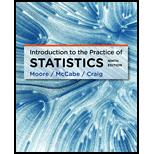
Concept explainers
(a)
To find: The predicted count values.
(a)
Answer to Problem 73E
Solution: The predicted count values are:
Explanation of Solution
Calculation: The provided least-squares regression equation is:
The time values are provided in the data as 1, 3, 5 and 7.
Substituting the values of time in the above linear regression equation, the following results are obtained:
For
For
For
For
Hence, the predicted count values obtained are
(b)
Section 1
To find: The difference between the observed and the predicted counts.
(b)
Section 1
Answer to Problem 73E
Solution: The differences obtained are
Explanation of Solution
Calculation: The respective observed counts are provided in the exercise as:
for the times
The respective predicted counts for the above times are obtained from part (a) as:
The differences
For
For
For
For
Hence, the differences obtained are
Section 2
The number of positive differences between the observed and the predicted counts.
Section 2
Answer to Problem 73E
Solution: The two positive differences are
Explanation of Solution
Clearly, the positive difference values are
The number of negative differences between the observed and the predicted counts.
Answer to Problem 73E
Solution: The two negative differences are
Explanation of Solution
Clearly, the negative difference values are
(c)
Section 1
To find: Squares of the differences obtained in part(b).
(c)
Section 1
Answer to Problem 73E
Solution: The squares of the differences are:
Explanation of Solution
Calculation: The differences obtained in the part (b) above are:
The squares of the differences obtained are calculated as follows:
The square of the difference
The square of the difference
The square of the difference
The square of the difference
Hence, the squares of the differences obtained are
Section 2
To find: The sum of the squares of the differences obtained in Section 1 above.
Section 2
Answer to Problem 73E
Solution: The sum of the differences obtained is
Explanation of Solution
Calculation: The squares of the differences are obtained in Section 1 above as:
The sum of the differences
Hence, the sum of the differences obtained is
(d)
Section 1
To find: The predicted count values.
(d)
Section 1
Answer to Problem 73E
Solution: The predicted count values obtained are:
Explanation of Solution
Calculation: The provided least-squares regression equation is:
The time values are provided in the data as 1, 3, 5 and 7.
Substituting the values of time in the above linear regression equation, the following results are obtained:
For
For
For
For
Hence, the predicted count values obtained are:
For the times 1, 3, 5 and 7 respectively.
Section 2:
To find: The difference between the observed and the predicted counts.
Section 2:
Answer to Problem 73E
Solution: The differences obtained are
Explanation of Solution
The differences
For
For
For
For
Hence, the differences obtained are
Section 3:
The number of positive differences between the observed and the predicted counts.
Section 3:
Answer to Problem 73E
Solution: The four positive differences are
Explanation of Solution
Clearly, all the difference values are positive. Hence, all the 4 differences
The number of negative differences between the observed and the predicted counts.
Answer to Problem 73E
Solution: There are no negative differences.
Explanation of Solution
Clearly, none of the values are negative. Hence, 0 out of 4 differences are negative.
Section 4:
To find: Squares of the differences obtained in section 2 of part (d).
Section 4:
Answer to Problem 73E
Solution: The squares of the differences are:
Explanation of Solution
Calculation: The differences obtained in the section 2 of part (d) above are:
The squares of the differences obtained are calculated as follows:
The square of the difference
The square of the difference
The square of the difference
The square of the difference
Hence, the squares of the differences obtained are
Section 5:
To find: The sum of the squares of the differences obtained in Section 3 above.
Section 5:
Answer to Problem 73E
Solution: The sum of the differences is
Explanation of Solution
The sum of the differences
Hence, the sum of the differences is
(e)
To explain: The least-squares inference based on the calculations performed.
(e)
Answer to Problem 73E
Solution: The following least-square regression is a better measure of the relationship between the count and the time:
Explanation of Solution
The differences (residuals) are both positive and negative values, whereas, for the regression line,
all the differences (residuals) are high and positive values. Thus, the residual plots for the first regression line will lie both below and above the x-axis. Also, its predicted regression line will lie much near to the observed regression line. Whereas, the residual plots for the second regression line will lie only above the x-axis. Also, with such high and positive differences, the predicted regression line will lie far to the observed regression line. Hence, the first line better depicts the relationship between the count and the time because it gives a better approximate value of the response variable.
Want to see more full solutions like this?
Chapter 2 Solutions
Introduction to the Practice of Statistics
 MATLAB: An Introduction with ApplicationsStatisticsISBN:9781119256830Author:Amos GilatPublisher:John Wiley & Sons Inc
MATLAB: An Introduction with ApplicationsStatisticsISBN:9781119256830Author:Amos GilatPublisher:John Wiley & Sons Inc Probability and Statistics for Engineering and th...StatisticsISBN:9781305251809Author:Jay L. DevorePublisher:Cengage Learning
Probability and Statistics for Engineering and th...StatisticsISBN:9781305251809Author:Jay L. DevorePublisher:Cengage Learning Statistics for The Behavioral Sciences (MindTap C...StatisticsISBN:9781305504912Author:Frederick J Gravetter, Larry B. WallnauPublisher:Cengage Learning
Statistics for The Behavioral Sciences (MindTap C...StatisticsISBN:9781305504912Author:Frederick J Gravetter, Larry B. WallnauPublisher:Cengage Learning Elementary Statistics: Picturing the World (7th E...StatisticsISBN:9780134683416Author:Ron Larson, Betsy FarberPublisher:PEARSON
Elementary Statistics: Picturing the World (7th E...StatisticsISBN:9780134683416Author:Ron Larson, Betsy FarberPublisher:PEARSON The Basic Practice of StatisticsStatisticsISBN:9781319042578Author:David S. Moore, William I. Notz, Michael A. FlignerPublisher:W. H. Freeman
The Basic Practice of StatisticsStatisticsISBN:9781319042578Author:David S. Moore, William I. Notz, Michael A. FlignerPublisher:W. H. Freeman Introduction to the Practice of StatisticsStatisticsISBN:9781319013387Author:David S. Moore, George P. McCabe, Bruce A. CraigPublisher:W. H. Freeman
Introduction to the Practice of StatisticsStatisticsISBN:9781319013387Author:David S. Moore, George P. McCabe, Bruce A. CraigPublisher:W. H. Freeman





